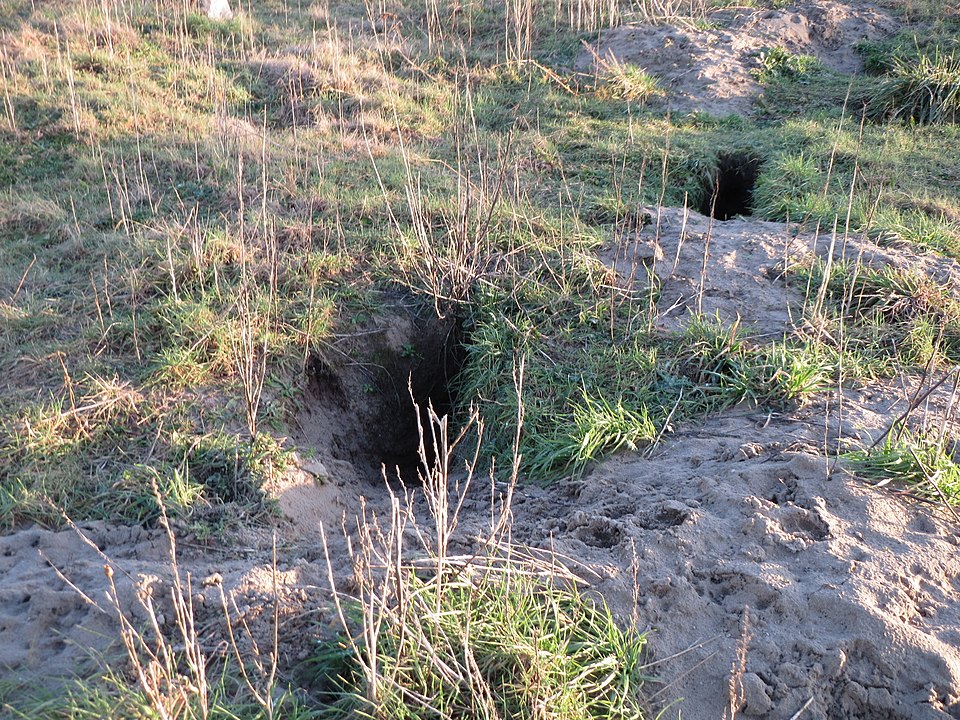Have you ever wondered how wild European rabbits live?
I my opinion their lives are more interesting than the ones of their domesticated descendants, bred for meat, fur, research, or companionship.
Here is a little insight into it.
European rabbits are the only leporidae (the family of hares and rabbits) to live in stable territorial social groups.
A group usually consists of 1-5 males (called bucks) and 1-9 females (does). Individuals of the same sex form dominance hierarchies. Higher rank gives males priority access to females, and thus a greater number of offspring. More dominant females have access to better nesting sites.
Competition for position occurs most often at the beginning of the breeding season and manifests itself in chases and even fierce fights. With time, as the hierarchy becomes more established, demonstrations of power tend to turn into ritualistic displays.
Among females, social position is often related to age. Older females have higher rank, and fights are more frequent between females of the same age.
Young males are usually driven away by the adults and leave. Females are more likely to stay in the group and therefore does in one colony are usually related to each other.
As the group grows, conflicts become more frequent, in time leading to a split. Usually, one or two females start spending their time on the periphery of the colony and new males start defending them, forming a new, separate group.
Rabbit colonies often use underground burrow systems they dug themselves.
Rabbit burrows provide shelter from predators and a place to safely birth young.
Most often females dig the burrows. When the ground is easy to dig, burrows are small with one entrance and one nest chamber. Individuals then occupy separate burrows but can move between them. When the ground is difficult to dig in, rabbits create over time long-lasting, extensive burrow systems (called warrens) with many entrances (up to 60) and several chambers. Several members of a group may use one warren.
Rabbits rarely spend time away from their burrows. Each individual has its own territory where it forages, although the territories of different individuals often overlap. Males usually have larger territories than females. In addition, males mark their territory with urine and secretions from special glands located in the groin and under the chin.

Although rabbits live in groups it seems that they actually prefer to avoid contact with each other.
Females try to keep a distance from each other, and when they are together for a longer period of time, for example during foraging, they are more likely to behave aggressively.
Each female prepares her own nest. When digging burrows is easy, females prefer to build separate burrows. And females living alone usually have the most young.
When digging new burrows is difficult, females sometimes try to take over the nursery burrow of another female. This can lead to infanticides, because the aggressor removes the old nest, including the young.
When the density of rabbits in a colony increases, females have fewer litters and fewer young. This is probably caused by the greater competition for burrows and increased stress at higher densities.
Rabbit mothers look after their babies in their own way.
The mother prepares for the arrival of the young by digging a new burrow or adapting an existing one. First, the female pads the nest with dry grass, and on the last night she adds hair torn from her own belly.
The young (called kits or kittens) are born almost naked and their eyes open after about 4-10 days. They stay in the nest for about three weeks. During this time, contact with the mother is limited to five minutes a day when the mother comes for the daily feeding. Limiting contact in this way probably helps to reduce the chance of predators finding the young. Additionally, when the mother leaves her young, she seals the entrance to the burrow. However, this does not always stop predators, so nests deep in the corridor system are best – these are occupied by dominant females whose offspring have a better chance of survival.
Although the mother does not stay with her young, she watches over them. She stays close to the burrow and quickly arrives when her offspring are disturbed. Even young that are only a few days old can emit high-pitched alarm calls. Sometimes even after the young have left the nest, the mother comes running when she hears their call.
In case of danger adult rabbits are known to thump their hindfeet on the ground. This may be a signal of danger to the young underground.
Main information sources: Rödel “Aspects of social behaviour and reproduction in the wild rabbit – Implications for rabbit breeding?” http://ojs.cc.upv.es/index.php/wrs/article/view/15954 and “The Encyclopedia of Mammals” edited by David W. Macdonald
Photos: Suju-foto from Pixabay; Warrens: By AnRo0002 – Own work, CC0, https://commons.wikimedia.org/w/index.php?curid=38180713
Polską wersję tego wpisu możesz znaleźć tutaj.


Nice, thank you. It is so sad that there are hardly any rabbits, not even on the Waddeneilanden, any more.
Indeed wild rabbit populations seem to be declining in many places, even in native Iberia. As a species they are classified as endangered.